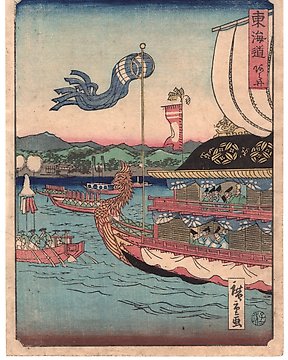
Arai あら井 - From the series 'Tôkaidô' 東海道 - 1864 - Utagawa Hiroshige II (Shigenobu) (1826–1869) - Japan - Späte Edo-Zeit
Nr. 83339677

Nr. 83339677

Original woodblock print – Paper – Utagawa Yoshitoyo 歌川芳豊 (1830-1866), text by Kanagaki Robun 仮名垣魯文 (1829-1894) – ‘Chūtenjiku Barukakoku shusshō shinto hakurai daizō no zu’ 中天竺馬爾加国出生新渡舶来大象之図 (Newly Imported Great Elephant Born in Malacca) – Japan – 1863 (Bunkyû 3)
This elephant in this picture came to Yokohama from Malacca on an American ship in 1862, and this picture was created at its showing in Ryōgoku the following year. Surprisingly, this elephant went on a provincial tour all over Japan that took more than 10 years. Although its charming figure skillfully using its long nose is familiar to us today, the sentence in the picture tells us that it was publicized as a fortunate animal that brought good luck to those who set eyes on it. We can feel how differently the people of Edo conceived elephants compared to people of today.
The signature says “Ichiryusai Yoshitoyo ga”一龍斎芳豊画”.
A disciple of Kunisada Utagawa and Kuniyoshi Utagawa. His real surname is Fukuyama, commonly known as Kanekichi (or 兼二郎Kanejirou). He is called Ichiryusai(一龍斎). At first he studied painting with Kunisada, but he left Kunisada and became a disciple of Kuniyoshi. Kuniyoshi was just when Kuniyoshi took the name of the second generation Toyokuni, so he intentionally gave him the name of Yoshitoyo. In other words, he put the letter “Toyo豊” under the letter “Yoshi芳”. His drawing period was from Ansei to Keio, and at the end of the Tokugawa shogunate, he was good at drawing animals and kites, and also painted Yokohama. He died in Nihonbashi Shin-Asakacho, 37 years old
So kaufen Sie auf Catawiki
1. Etwas Besonderes entdecken
2. Höchstgebot abgeben
3. Sichere Zahlung durchführen